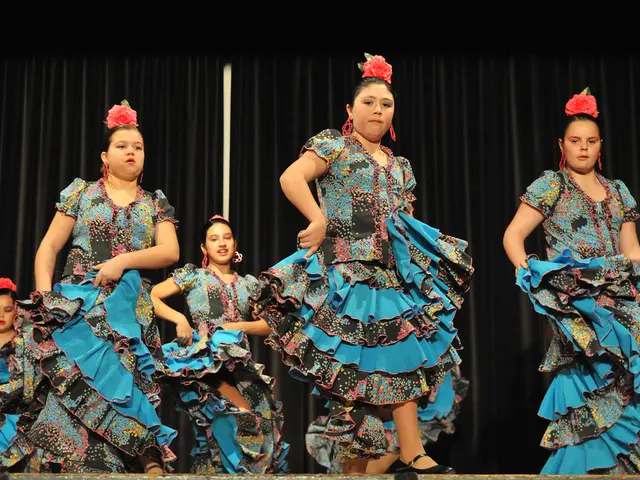Museums blending digital and physical experiences in a world impacted by the pandemic?
International Digital Art Festival Highlights Museums' Embrace of Digital Technology
From April 14th to 16th, 2021, the Réunion des Musées Nationaux - Grand Palais and the Palace of Versailles took part in the online Recto VRso international digital art festival, showcasing digital tools and innovative technologies for art creation and dissemination. A panel discussion, moderated by Urszula Gleisner, also addressed the emergence of hybrid museums.
Traditional museums face unprecedented changes in the wake of the global pandemic, which has accelerated the digital transformation of cultural institutions. Museums closed their doors, temporarily relying on digital solutions as a backup. However, some have found this transition challenging, raising questions about how to present virtual content from physical artifacts and provide visitors with an engaging experience from a distance.
"Art galleries and exhibitions were the first victims of the Covid crisis," explained Roei Amit, Digital & Multimedia Manager at the Réunion des Musées Nationaux - Grand Palais. In response, cultural institutions have sought new ways to bring culture to visitors, embracing technology and adopting innovative approaches to keep their audiences connected.
One example is the Palace of Versailles, which accelerated its digital transformation during the pandemic. In 2018, the Palace launched Virtually Versailles, an interactive walk that provided a virtual tour of the esteemed establishment's history. In 2020, the institution partnered with Google Arts & Culture to offer an immersive experience featuring photogrammetry technology. Other examples of exhibitions relying on XR technology for virtual tours include "Black & White" at the Grand Palais and "Women Painters" at the Musée de Luxembourg.
The use of digital technologies has given rise to hybrid museums, blending physical and virtual elements to create new visitor experiences. RMN-Grand Palais has established its subsidiary, Grand Palais Immersif, to produce digital exhibitions, as the virtualization of space enriches the on-site visit. At the Palace of Versailles, the virtual visit helps visitors prepare for their physical visit due to the enormous size and complexity of the palace. The virtual exhibition experience can also reach diverse audiences, including those who may not have been able to visit the palace otherwise.
As museums embark on this digital transformation journey, they face the challenge of engaging with virtual worlds. Artists, too, have had to adapt to this new reality, experimenting with technology and exhibiting their works in novel ways. According to Valentino Catricalà, curator of the SODA Gallery, the pandemic has inspired artists to create digital content fearlessly.
Soh Yeong Roh, director of Art Center Nabi, noted that the era of creators has arrived. With cultural institutions temporarily closed, artists can now freely create and sell their work using blockchain technology, which ensures the authenticity of digital artworks. The pandemic has demonstrated that digital artworks can be successful and profitable, particularly as they offer added benefits like cost savings and ease of distribution.
In conclusion, the pandemic has accelerated the digital transformation of traditional museums, leading to the advent of hybrid museums and an increased emphasis on digital engagement. Museums will continue to adapt their practices and focus on digital experiences, aiming to provide innovative and accessible ways for visitors to engage with art and culture. Amid the challenges of this transition, opportunities for growth and collaboration abound.
[1] "The Impact of the COVID-19 Pandemic on Cultural Institutions," Brookings Institution, June 2020.[2] "Post-pandemic Reopening Strategies for Museums," American Alliance of Museums, 2021.[3] "Digital Transformation in Museums: The Pandemic as a Catalyst for Change," Europeana, July 2020.[4] "The Future of Museums: Navigating the Impact of Digitalization and Climate Change," World Economic Forum, February 2020.
[1] In the realm of lifestyle and education-and-self-development, the digital transformation of traditional museums is a significant trend influenced by the pandemic, as the advent of hybrid museums signifies a blend of home-and-garden (physical) and data-and-cloud-computing (virtual) experiences, transforming the way we engage with art and culture.
[2] The Palace of Versailles, for instance, utilizing technology such as XR technology and partnerships with companies like Google Arts & Culture, offers an immersive educational experience through online-education platforms, catering not only to visitors who cannot physically attend but also to those embracing sustainable-living practices by reducing carbon footprint from travel.
[3] Artists, in turn, have leveraged artificial-intelligence (AI) and other digital tools to create novel works, exploring new possibilities brought about by this transformation. One notable example is the use of blockchain technology, allowing artists to protect the authenticity of their digital creations and sell them directly to audiences, promoting easy distribution and cost savings.
[4] As these changes unfold, it is essential for cultural institutions to address the challenges posed by digital engagement and continue to adapt their practices, ensuring that art remains accessible amid this ongoing transformation. The implications of this shift for the broader cultural landscape will undoubtedly be significant, warranting further study and discussion.







